Abstract
OBJECTIVE: The authors sought to determine how temporary insulin suppression might alter the catabolic effects of cortisol, glucagon, and epinephrine. SUMMARY BACKGROUND DATA: The metabolic responses to injury include hypermetabolism, accelerated net skeletal muscle protein breakdown, glucose intolerance, and insulin resistance. These alterations are associated with increased stress hormone concentrations. Insulin elaboration is usually suppressed immediately after an injury but is abundant later during convalescence. An infusion of hydrocortisone, glucagon, and epinephrine increases both stress hormone concentrations and insulin levels. It induces many of the metabolic alterations seen in critically ill patients, but it does not affect net muscle breakdown. METHODS: Seven healthy adults received a stress hormone infusion for 3 days in two separate studies. During one study they, also received an infusion of the somatostatin analogue, octreotide (0.005 micrograms/kg/min), to suppress insulin elaboration for the first 24 hours. During the other study (control), insulin was permitted to rise unchecked. RESULTS: Stress hormone concentrations, hypermetabolism (+/- 20% above basal), and leukocytosis were similar during both study periods. When insulin elaboration was temporarily suppressed, whole-body nitrogen loss was increased during the first 48 hours, and the efflux of amino acids from the forearm after 72 hours of infusion was 60% greater than the control level. CONCLUSIONS: Temporary insulin suppression during physiologic increases in stress hormone concentrations amplified whole-body nitrogen loss and led to the development of accelerated net skeletal muscle protein breakdown. Early hormonal changes after an injury may affect the development of later catabolic responses.
Full text
PDF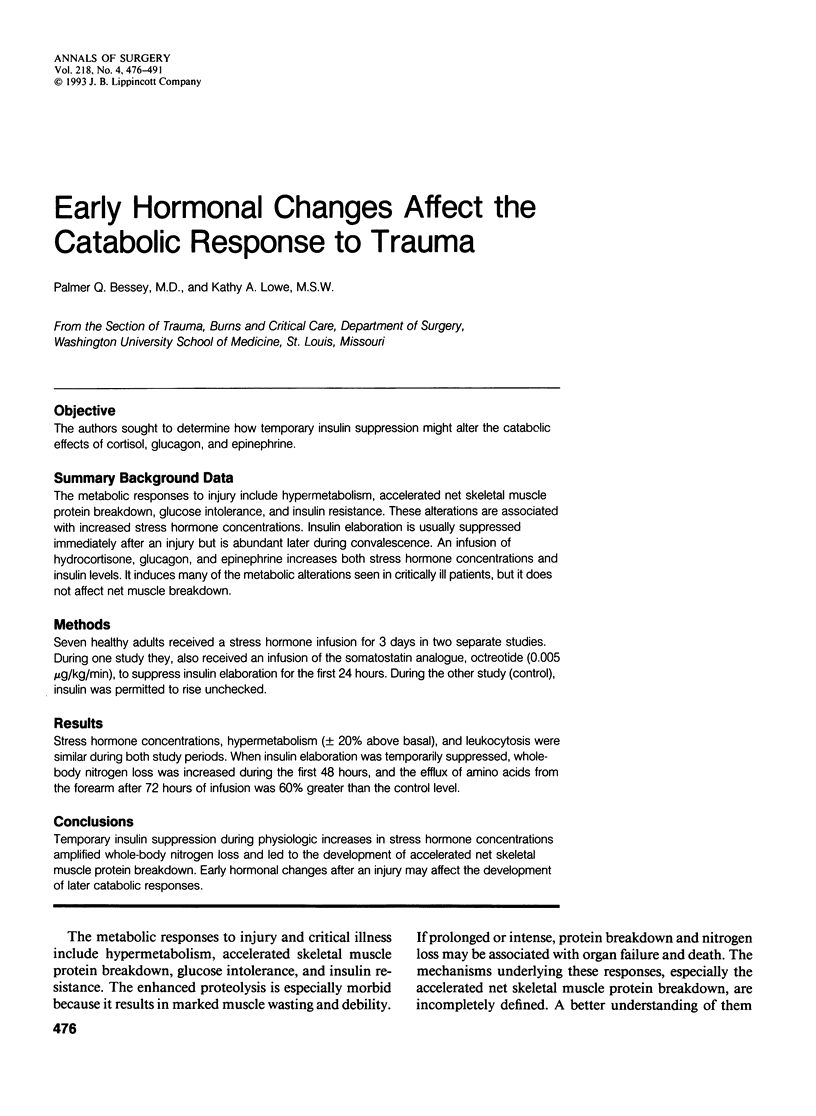

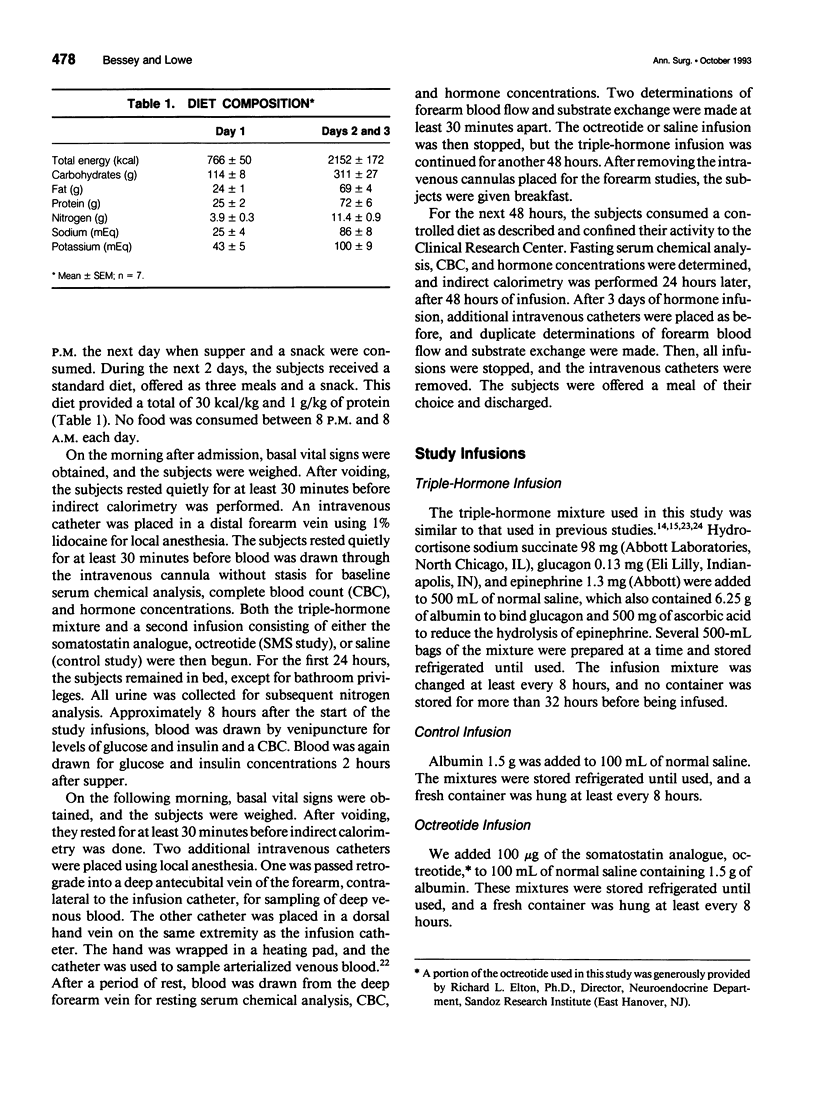
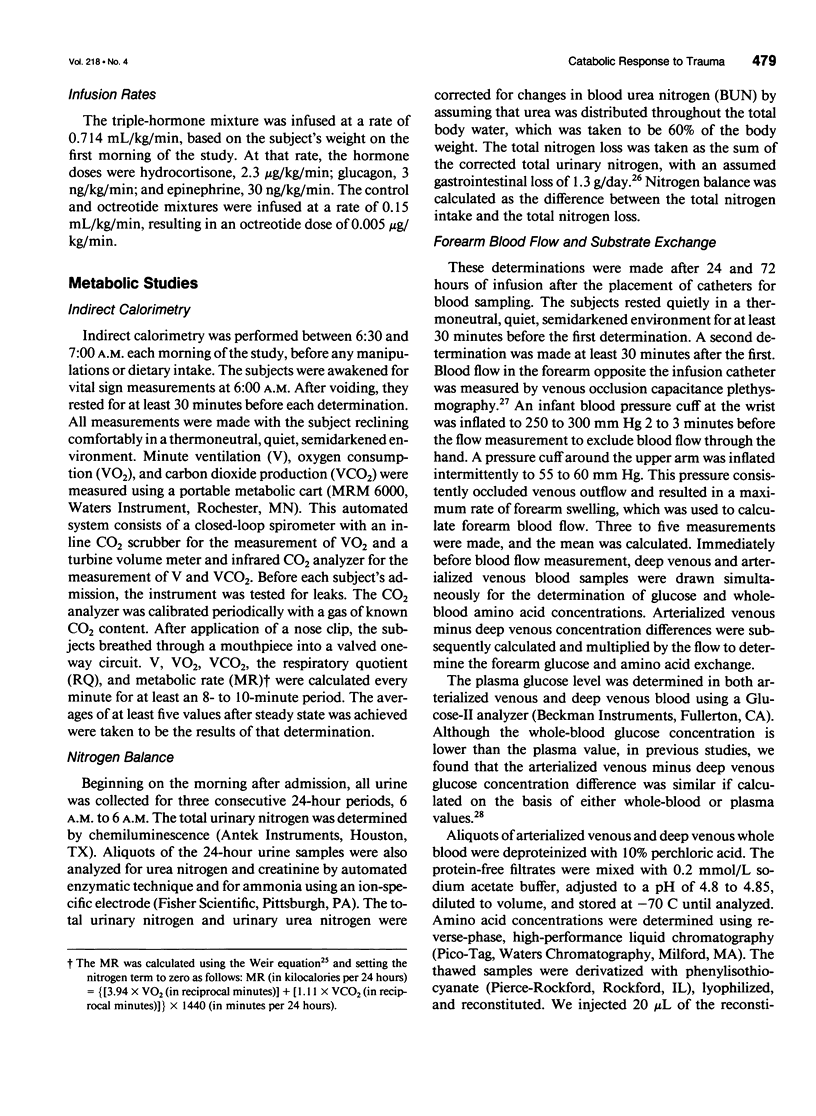
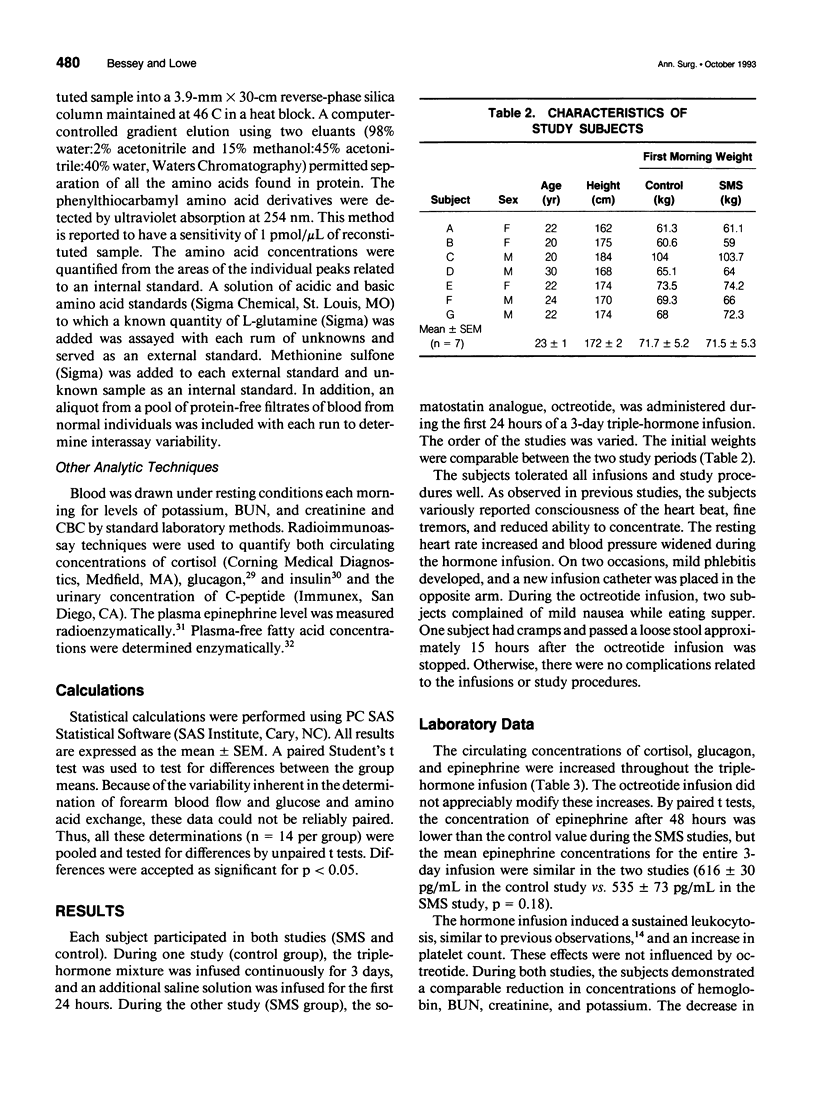
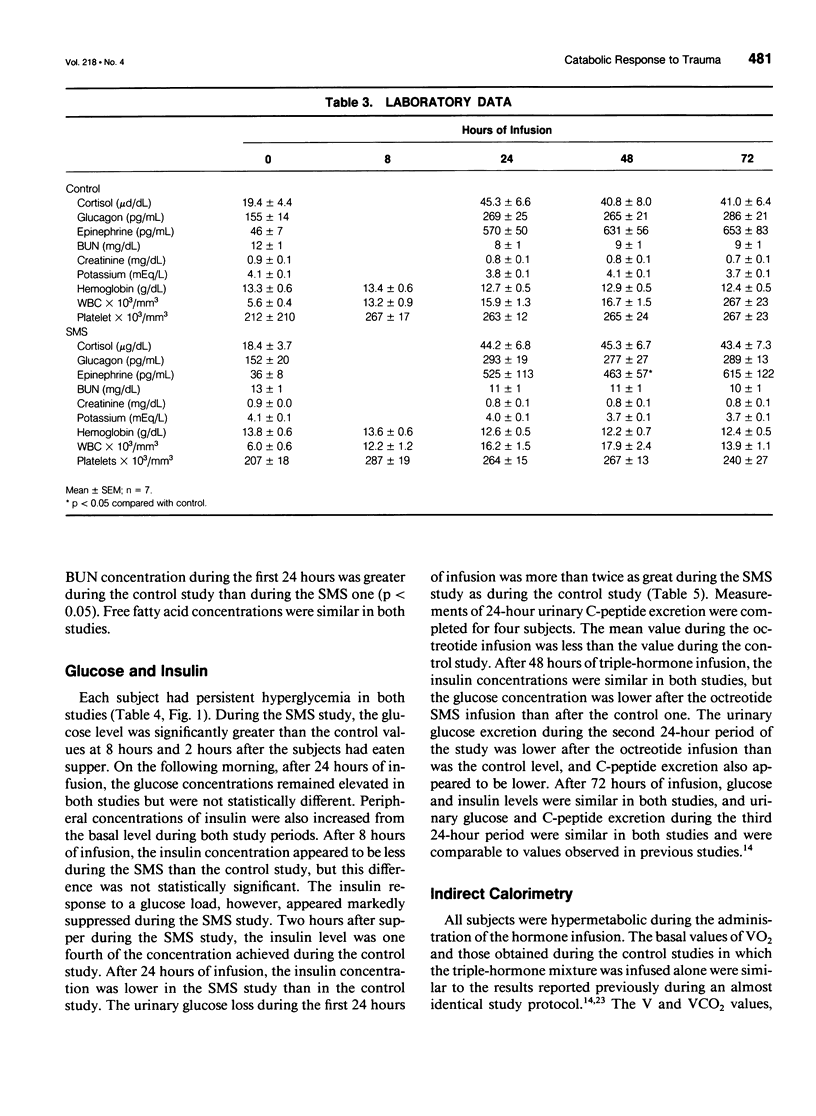
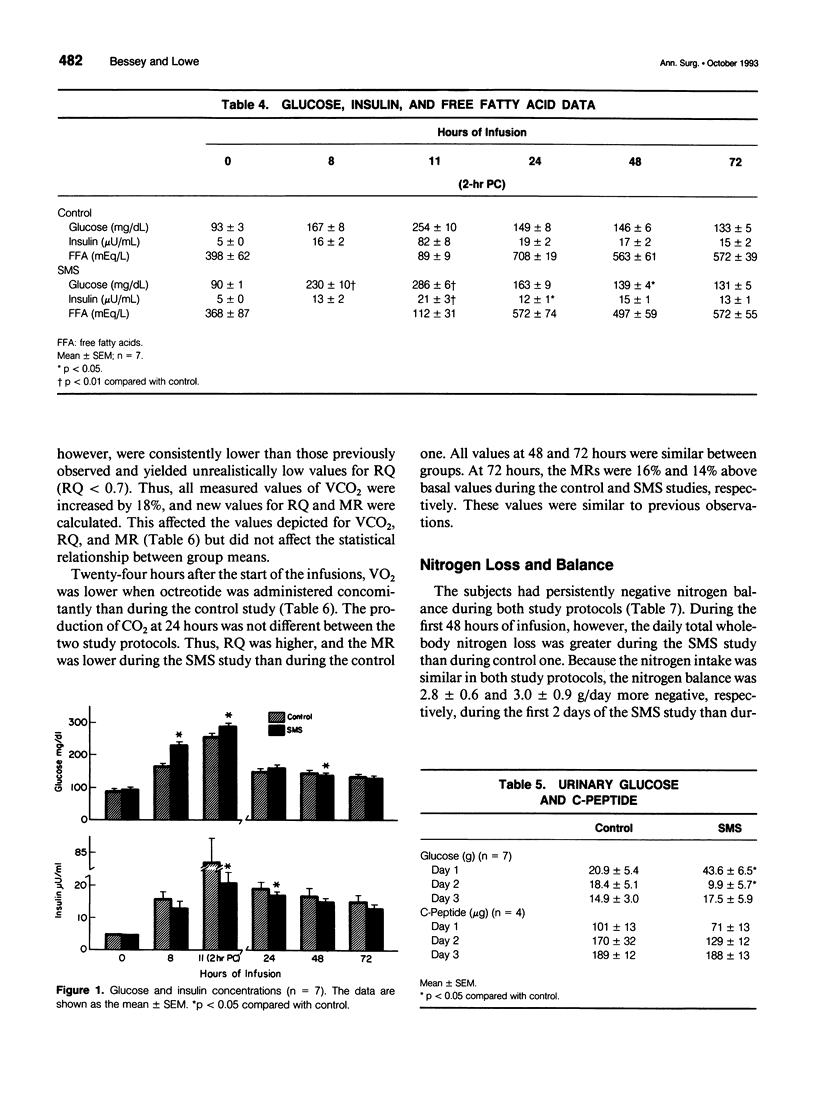
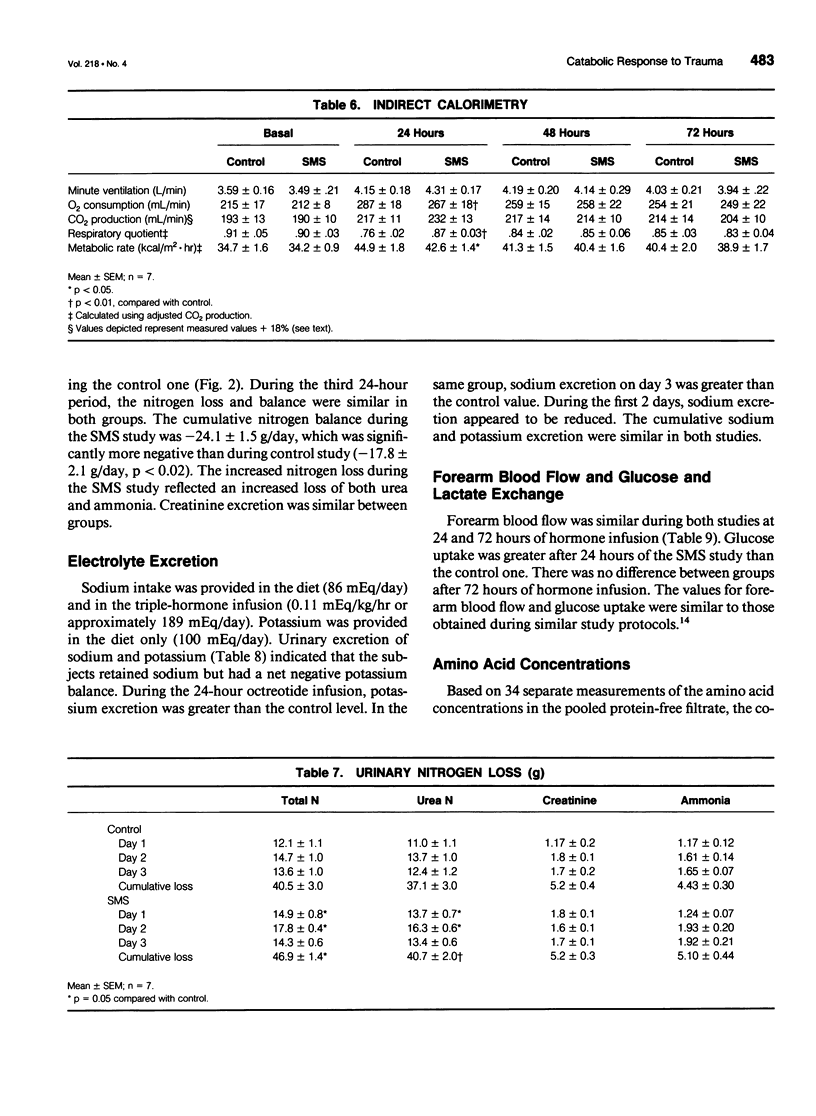
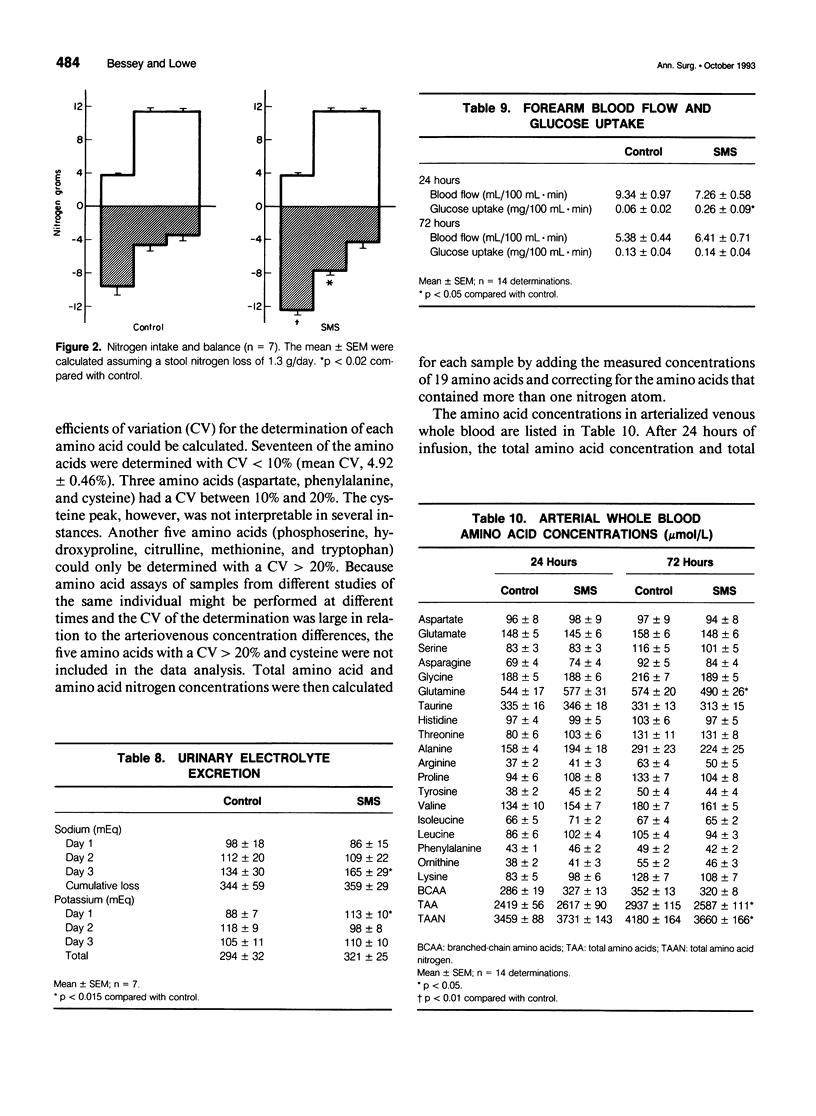
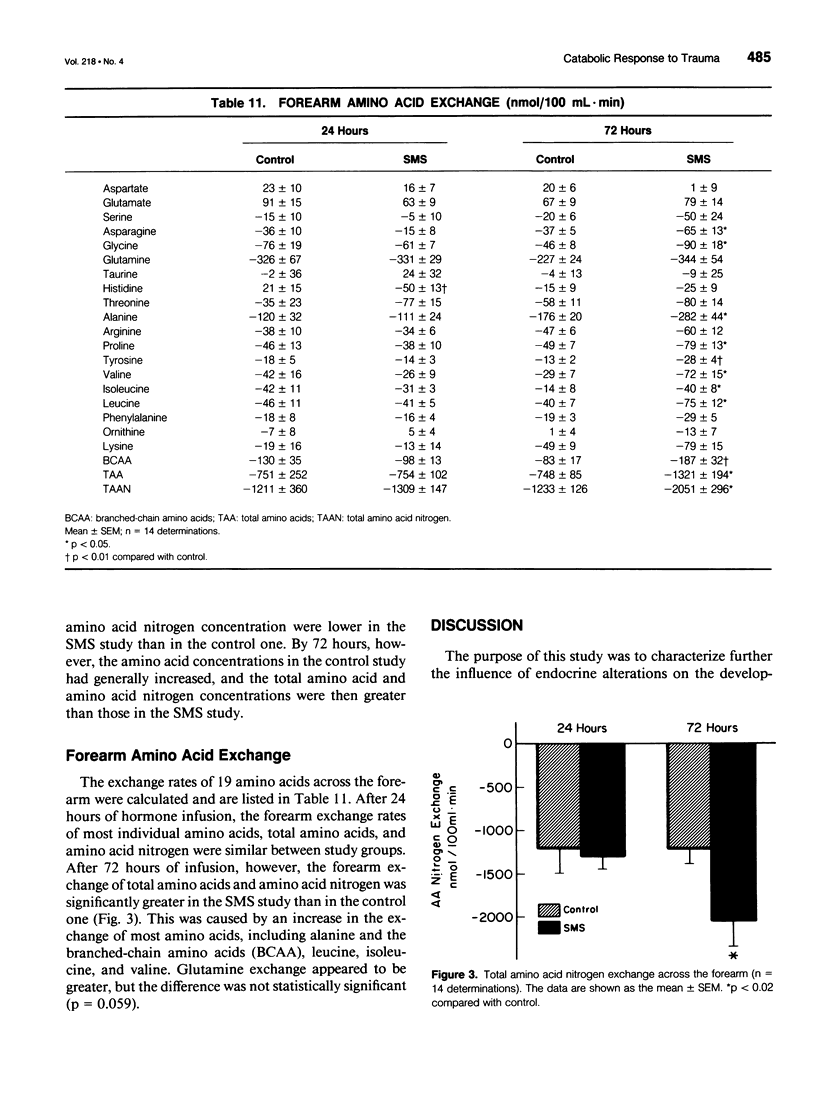
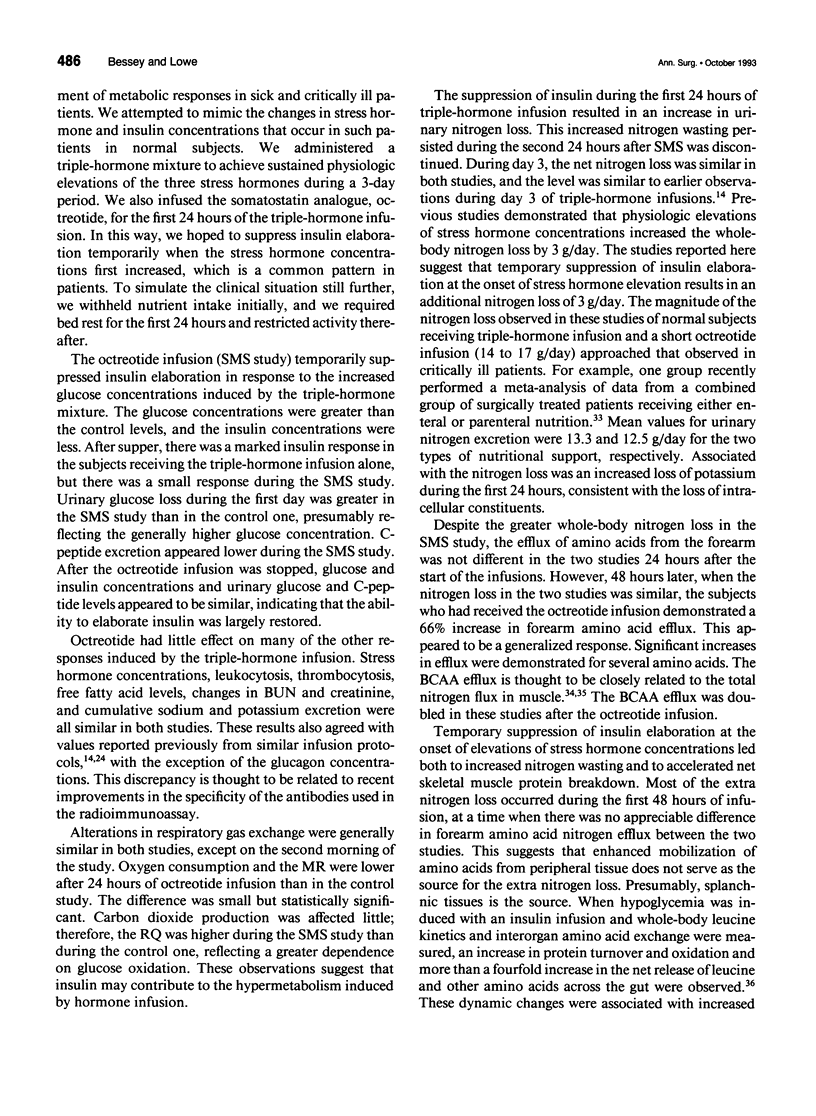
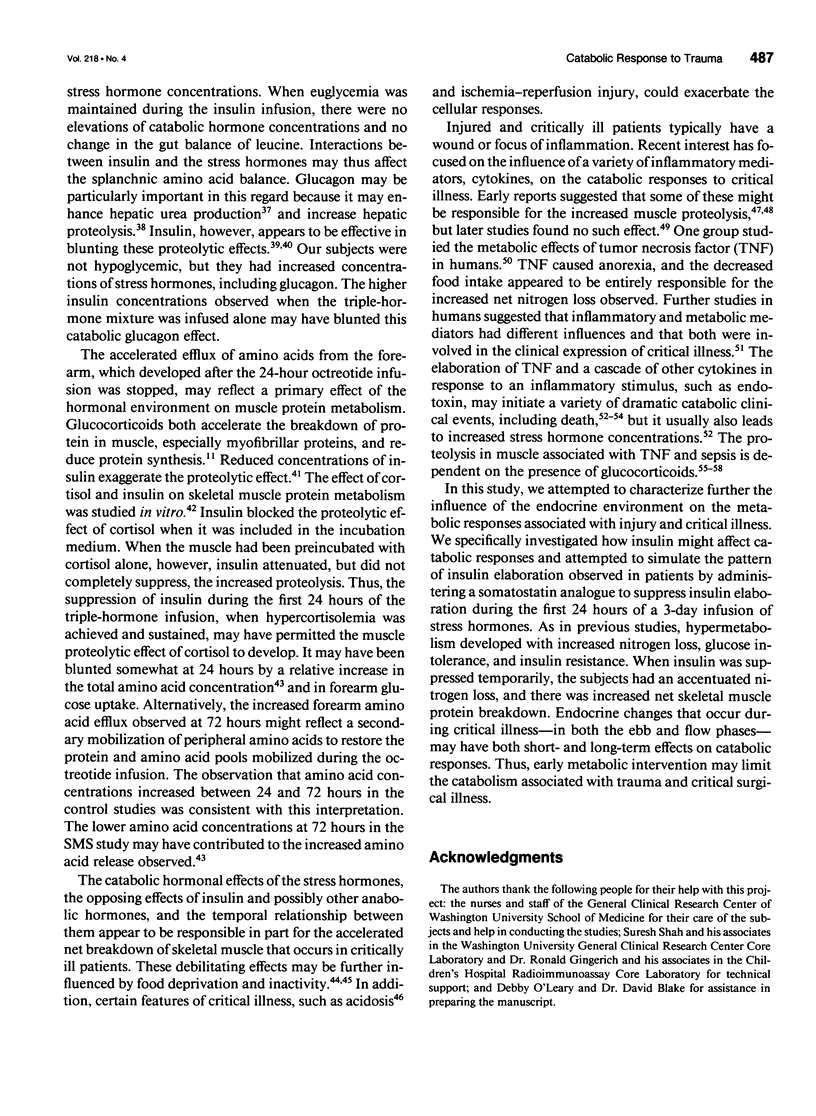
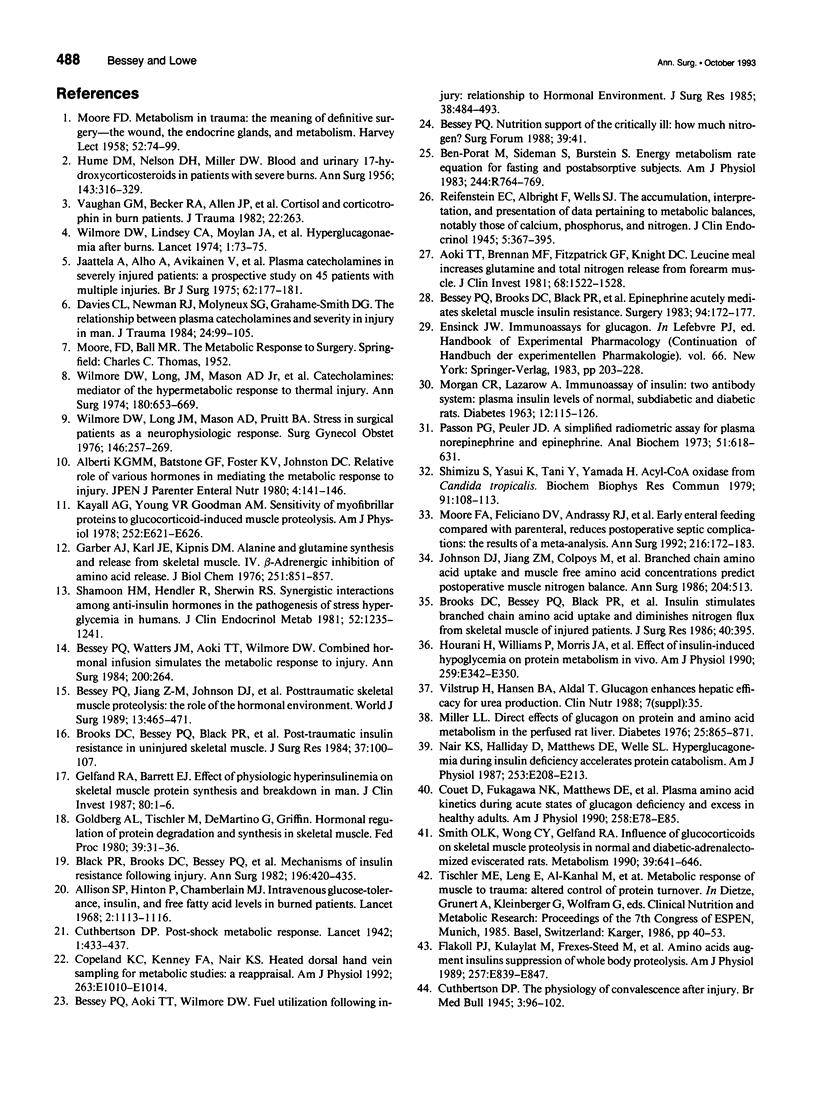
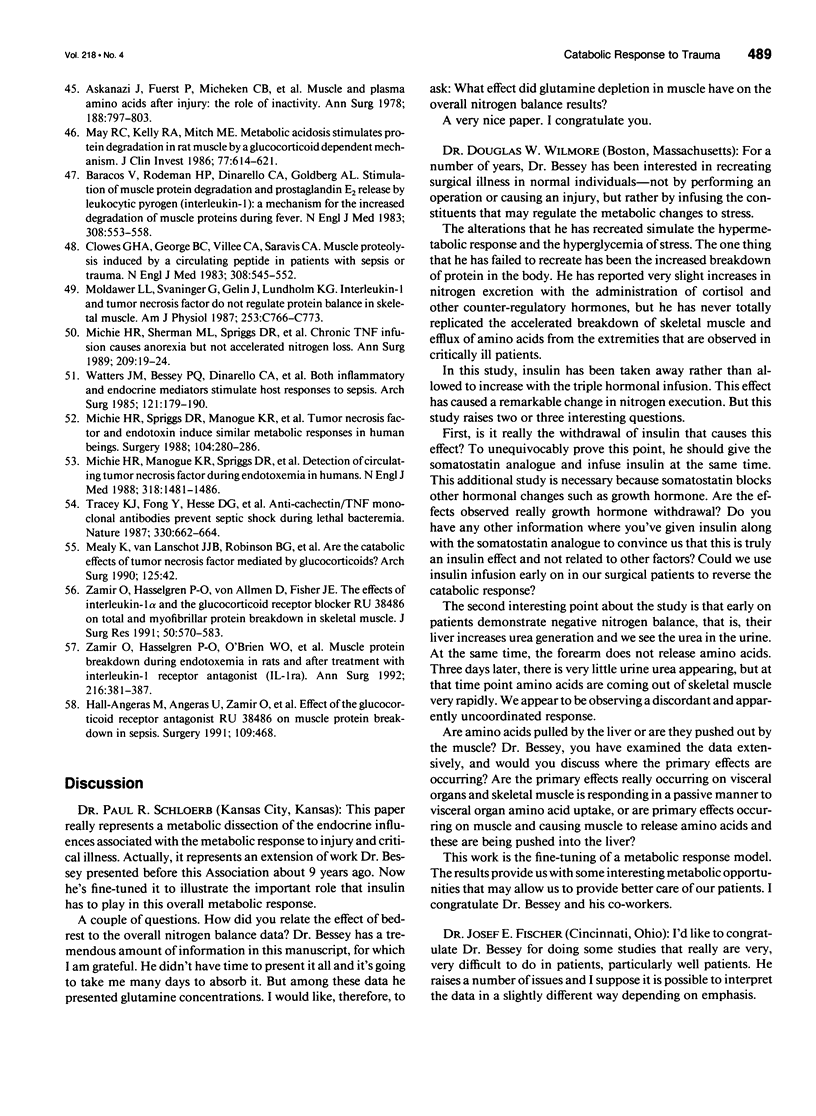
Selected References
These references are in PubMed. This may not be the complete list of references from this article.
- Alberti K. G., Batstone G. F., Foster K. J., Johnston D. G. Relative role of various hormones in mediating the metabolic response to injury. JPEN J Parenter Enteral Nutr. 1980 Mar-Apr;4(2):141–146. doi: 10.1177/014860718000400214. [DOI] [PubMed] [Google Scholar]
- Allison S. P., Hinton P., Chamberlain M. J. Intravenous glucose-tolerance, insulin, and free-fatty-acid levels in burned patients. Lancet. 1968 Nov 23;2(7578):1113–1116. doi: 10.1016/s0140-6736(68)91581-x. [DOI] [PubMed] [Google Scholar]
- Aoki T. T., Brennan M. F., Fitzpatrick G. F., Knight D. C. Leucine meal increases glutamine and total nitrogen release from forearm muscle. J Clin Invest. 1981 Dec;68(6):1522–1528. doi: 10.1172/JCI110406. [DOI] [PMC free article] [PubMed] [Google Scholar]
- Askanazi J., Elwyn D. H., Kinney J. M., Gump F. E., Michelsen C. B., Stinchfield F. E., Fürst P., Vinnars E., Bergström J. Muscle and plasma amino acids after injury: the role of inactivity. Ann Surg. 1978 Dec;188(6):797–803. doi: 10.1097/00000658-197812000-00014. [DOI] [PMC free article] [PubMed] [Google Scholar]
- Baracos V., Rodemann H. P., Dinarello C. A., Goldberg A. L. Stimulation of muscle protein degradation and prostaglandin E2 release by leukocytic pyrogen (interleukin-1). A mechanism for the increased degradation of muscle proteins during fever. N Engl J Med. 1983 Mar 10;308(10):553–558. doi: 10.1056/NEJM198303103081002. [DOI] [PubMed] [Google Scholar]
- Ben-Porat M., Sideman S., Bursztein S. Energy metabolism rate equation for fasting and postabsorptive subjects. Am J Physiol. 1983 Jun;244(6):R764–R769. doi: 10.1152/ajpregu.1983.244.6.R764. [DOI] [PubMed] [Google Scholar]
- Bessey P. Q., Aoki T. T., Wilmore D. W. Fuel utilization following injury: relationship to hormonal environment. J Surg Res. 1985 May;38(5):484–493. doi: 10.1016/0022-4804(85)90066-6. [DOI] [PubMed] [Google Scholar]
- Bessey P. Q., Brooks D. C., Black P. R., Aoki T. T., Wilmore D. W. Epinephrine acutely mediates skeletal muscle insulin resistance. Surgery. 1983 Aug;94(2):172–179. [PubMed] [Google Scholar]
- Bessey P. Q., Jiang Z. M., Johnson D. J., Smith R. J., Wilmore D. W. Posttraumatic skeletal muscle proteolysis: the role of the hormonal environment. World J Surg. 1989 Jul-Aug;13(4):465–471. doi: 10.1007/BF01660758. [DOI] [PubMed] [Google Scholar]
- Bessey P. Q., Watters J. M., Aoki T. T., Wilmore D. W. Combined hormonal infusion simulates the metabolic response to injury. Ann Surg. 1984 Sep;200(3):264–281. doi: 10.1097/00000658-198409000-00004. [DOI] [PMC free article] [PubMed] [Google Scholar]
- Black P. R., Brooks D. C., Bessey P. Q., Wolfe R. R., Wilmore D. W. Mechanisms of insulin resistance following injury. Ann Surg. 1982 Oct;196(4):420–435. doi: 10.1097/00000658-198210000-00005. [DOI] [PMC free article] [PubMed] [Google Scholar]
- Brooks D. C., Bessey P. Q., Black P. R., Aoki T. T., Wilmore D. W. Insulin stimulates branched chain amino acid uptake and diminishes nitrogen flux from skeletal muscle of injured patients. J Surg Res. 1986 Apr;40(4):395–405. doi: 10.1016/0022-4804(86)90205-2. [DOI] [PubMed] [Google Scholar]
- Brooks D. C., Bessey P. Q., Black P. R., Aoki T. T., Wilmore D. W. Post-traumatic insulin resistance in uninjured forearm tissue. J Surg Res. 1984 Aug;37(2):100–107. doi: 10.1016/0022-4804(84)90168-9. [DOI] [PubMed] [Google Scholar]
- Clowes G. H., Jr, George B. C., Villee C. A., Jr, Saravis C. A. Muscle proteolysis induced by a circulating peptide in patients with sepsis or trauma. N Engl J Med. 1983 Mar 10;308(10):545–552. doi: 10.1056/NEJM198303103081001. [DOI] [PubMed] [Google Scholar]
- Couet C., Fukagawa N. K., Matthews D. E., Bier D. M., Young V. R. Plasma amino acid kinetics during acute states of glucagon deficiency and excess in healthy adults. Am J Physiol. 1990 Jan;258(1 Pt 1):E78–E85. doi: 10.1152/ajpendo.1990.258.1.E78. [DOI] [PubMed] [Google Scholar]
- Davies C. L., Newman R. J., Molyneux S. G., Grahame-Smith D. G. The relationship between plasma catecholamines and severity of injury in man. J Trauma. 1984 Feb;24(2):99–105. doi: 10.1097/00005373-198402000-00002. [DOI] [PubMed] [Google Scholar]
- Flakoll P. J., Kulaylat M., Frexes-Steed M., Hourani H., Brown L. L., Hill J. O., Abumrad N. N. Amino acids augment insulin's suppression of whole body proteolysis. Am J Physiol. 1989 Dec;257(6 Pt 1):E839–E847. doi: 10.1152/ajpendo.1989.257.6.E839. [DOI] [PubMed] [Google Scholar]
- Garber A. J., Karl I. E., Kipnis D. M. Alanine and glutamine synthesis and release from skeletal muscle. IV. beta-Adrenergic inhibition of amino acid release. J Biol Chem. 1976 Feb 10;251(3):851–857. [PubMed] [Google Scholar]
- Gelfand R. A., Barrett E. J. Effect of physiologic hyperinsulinemia on skeletal muscle protein synthesis and breakdown in man. J Clin Invest. 1987 Jul;80(1):1–6. doi: 10.1172/JCI113033. [DOI] [PMC free article] [PubMed] [Google Scholar]
- Goldberg A. L., Tischler M., DeMartino G., Griffin G. Hormonal regulation of protein degradation and synthesis in skeletal muscle. Fed Proc. 1980 Jan;39(1):31–36. [PubMed] [Google Scholar]
- HUME D. M., NELSON D. H., MILLER D. W. Blood and urinary 17-hydroxycorticosteroids in patients with severe burns. Ann Surg. 1956 Mar;143(3):316–329. doi: 10.1097/00000658-195603000-00004. [DOI] [PMC free article] [PubMed] [Google Scholar]
- Hall-Angerås M., Angerås U., Zamir O., Hasselgren P. O., Fischer J. E. Effect of the glucocorticoid receptor antagonist RU 38486 on muscle protein breakdown in sepsis. Surgery. 1991 Apr;109(4):468–473. [PubMed] [Google Scholar]
- Hourani H., Williams P., Morris J. A., May M. E., Abumrad N. N. Effect of insulin-induced hypoglycemia on protein metabolism in vivo. Am J Physiol. 1990 Sep;259(3 Pt 1):E342–E350. doi: 10.1152/ajpendo.1990.259.3.E342. [DOI] [PubMed] [Google Scholar]
- Johnson D. J., Jiang Z. M., Colpoys M., Kapadia C. R., Smith R. J., Wilmore D. W. Branched chain amino acid uptake and muscle free amino acid concentrations predict postoperative muscle nitrogen balance. Ann Surg. 1986 Nov;204(5):513–523. doi: 10.1097/00000658-198611000-00002. [DOI] [PMC free article] [PubMed] [Google Scholar]
- Jättelä A., Alho A., Avikainen V., Karaharju E., Kataja J., Lahdensuu M., Lepistö P., Rokkanen P., Tervo T. Plasma catecholamines in severely injured patients: a prospective study on 45 patients with multiple injuries. Br J Surg. 1975 Mar;62(3):177–181. doi: 10.1002/bjs.1800620303. [DOI] [PubMed] [Google Scholar]
- Kayali A. G., Young V. R., Goodman M. N. Sensitivity of myofibrillar proteins to glucocorticoid-induced muscle proteolysis. Am J Physiol. 1987 May;252(5 Pt 1):E621–E626. doi: 10.1152/ajpendo.1987.252.5.E621. [DOI] [PubMed] [Google Scholar]
- May R. C., Kelly R. A., Mitch W. E. Metabolic acidosis stimulates protein degradation in rat muscle by a glucocorticoid-dependent mechanism. J Clin Invest. 1986 Feb;77(2):614–621. doi: 10.1172/JCI112344. [DOI] [PMC free article] [PubMed] [Google Scholar]
- Mealy K., van Lanschot J. J., Robinson B. G., Rounds J., Wilmore D. W. Are the catabolic effects of tumor necrosis factor mediated by glucocorticoids? Arch Surg. 1990 Jan;125(1):42–48. doi: 10.1001/archsurg.1990.01410130044006. [DOI] [PubMed] [Google Scholar]
- Michie H. R., Manogue K. R., Spriggs D. R., Revhaug A., O'Dwyer S., Dinarello C. A., Cerami A., Wolff S. M., Wilmore D. W. Detection of circulating tumor necrosis factor after endotoxin administration. N Engl J Med. 1988 Jun 9;318(23):1481–1486. doi: 10.1056/NEJM198806093182301. [DOI] [PubMed] [Google Scholar]
- Michie H. R., Sherman M. L., Spriggs D. R., Rounds J., Christie M., Wilmore D. W. Chronic TNF infusion causes anorexia but not accelerated nitrogen loss. Ann Surg. 1989 Jan;209(1):19–24. doi: 10.1097/00000658-198901000-00002. [DOI] [PMC free article] [PubMed] [Google Scholar]
- Michie H. R., Spriggs D. R., Manogue K. R., Sherman M. L., Revhaug A., O'Dwyer S. T., Arthur K., Dinarello C. A., Cerami A., Wolff S. M. Tumor necrosis factor and endotoxin induce similar metabolic responses in human beings. Surgery. 1988 Aug;104(2):280–286. [PubMed] [Google Scholar]
- Miller L. L. Direct effects of glucagon on protein and amino acid metabolism in the isolated perfused rat liver. Interactions with insulin and dexamethasone in net synthesis of albumin and acute-phase proteins. Diabetes. 1976;25(2 Suppl):865–871. [PubMed] [Google Scholar]
- Moldawer L. L., Svaninger G., Gelin J., Lundholm K. G. Interleukin 1 and tumor necrosis factor do not regulate protein balance in skeletal muscle. Am J Physiol. 1987 Dec;253(6 Pt 1):C766–C773. doi: 10.1152/ajpcell.1987.253.6.C766. [DOI] [PubMed] [Google Scholar]
- Moore F. A., Feliciano D. V., Andrassy R. J., McArdle A. H., Booth F. V., Morgenstein-Wagner T. B., Kellum J. M., Jr, Welling R. E., Moore E. E. Early enteral feeding, compared with parenteral, reduces postoperative septic complications. The results of a meta-analysis. Ann Surg. 1992 Aug;216(2):172–183. doi: 10.1097/00000658-199208000-00008. [DOI] [PMC free article] [PubMed] [Google Scholar]
- Nair K. S., Halliday D., Matthews D. E., Welle S. L. Hyperglucagonemia during insulin deficiency accelerates protein catabolism. Am J Physiol. 1987 Aug;253(2 Pt 1):E208–E213. doi: 10.1152/ajpendo.1987.253.2.E208. [DOI] [PubMed] [Google Scholar]
- Passon P. G., Peuler J. D. A simplified radiometric assay for plasma norepinephrine and epinephrine. Anal Biochem. 1973 Feb;51(2):618–631. doi: 10.1016/0003-2697(73)90517-4. [DOI] [PubMed] [Google Scholar]
- Shamoon H., Hendler R., Sherwin R. S. Synergistic interactions among antiinsulin hormones in the pathogenesis of stress hyperglycemia in humans. J Clin Endocrinol Metab. 1981 Jun;52(6):1235–1241. doi: 10.1210/jcem-52-6-1235. [DOI] [PubMed] [Google Scholar]
- Shimizu S., Yasui K., Tani Y., Yamada H. Acyl-CoA oxidase from Candida tropicalis. Biochem Biophys Res Commun. 1979 Nov 14;91(1):108–113. doi: 10.1016/0006-291x(79)90589-8. [DOI] [PubMed] [Google Scholar]
- Smith O. L., Wong C. Y., Gelfand R. A. Influence of glucocorticoids on skeletal muscle proteolysis in normal and diabetic-adrenalectomized eviscerated rats. Metabolism. 1990 Jun;39(6):641–646. doi: 10.1016/0026-0495(90)90033-9. [DOI] [PubMed] [Google Scholar]
- Tracey K. J., Fong Y., Hesse D. G., Manogue K. R., Lee A. T., Kuo G. C., Lowry S. F., Cerami A. Anti-cachectin/TNF monoclonal antibodies prevent septic shock during lethal bacteraemia. Nature. 1987 Dec 17;330(6149):662–664. doi: 10.1038/330662a0. [DOI] [PubMed] [Google Scholar]
- Vaughan G. M., Becker R. A., Allen J. P., Goodwin C. W., Jr, Pruitt B. A., Jr, Mason A. D., Jr Cortisol and corticotrophin in burned patients. J Trauma. 1982 Apr;22(4):263–273. doi: 10.1097/00005373-198204000-00001. [DOI] [PubMed] [Google Scholar]
- Watters J. M., Bessey P. Q., Dinarello C. A., Wolff S. M., Wilmore D. W. Both inflammatory and endocrine mediators stimulate host responses to sepsis. Arch Surg. 1986 Feb;121(2):179–190. doi: 10.1001/archsurg.1986.01400020065008. [DOI] [PubMed] [Google Scholar]
- Wilmore D. W., Lindsey C. A., Moyland J. A., Faloona G. R., Pruitt B. A., Unger R. H. Hyperglucagonaemia after burns. Lancet. 1974 Jan 19;1(7847):73–75. doi: 10.1016/s0140-6736(74)92290-9. [DOI] [PubMed] [Google Scholar]
- Wilmore D. W., Long J. M., Mason A. D., Jr, Skreen R. W., Pruitt B. A., Jr Catecholamines: mediator of the hypermetabolic response to thermal injury. Ann Surg. 1974 Oct;180(4):653–669. doi: 10.1097/00000658-197410000-00031. [DOI] [PMC free article] [PubMed] [Google Scholar]
- Wilmore D. W., Long J. M., Mason A. D., Pruitt B. A., Jr Stress in surgical patients as a neurophysiologic reflex response. Surg Gynecol Obstet. 1976 Feb;142(2):257–269. [PubMed] [Google Scholar]
- Zamir O., Hasselgren P. O., O'Brien W., Thompson R. C., Fischer J. E. Muscle protein breakdown during endotoxemia in rats and after treatment with interleukin-1 receptor antagonist (IL-1ra). Ann Surg. 1992 Sep;216(3):381–387. doi: 10.1097/00000658-199209000-00018. [DOI] [PMC free article] [PubMed] [Google Scholar]
- Zamir O., Hasselgren P. O., von Allmen D., Fischer J. E. The effect of interleukin-1 alpha and the glucocorticoid receptor blocker RU 38486 on total and myofibrillar protein breakdown in skeletal muscle. J Surg Res. 1991 Jun;50(6):579–583. doi: 10.1016/0022-4804(91)90045-n. [DOI] [PubMed] [Google Scholar]


